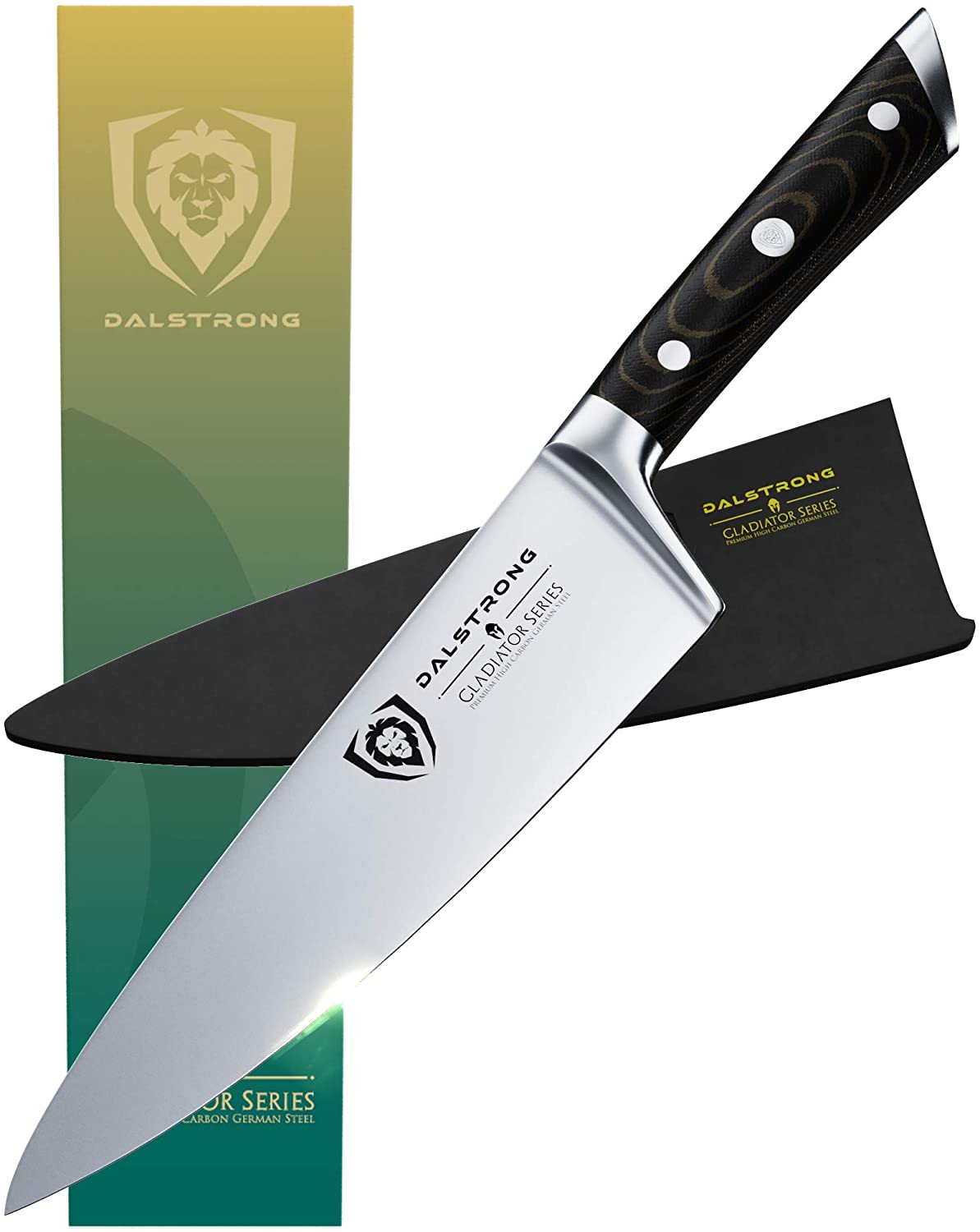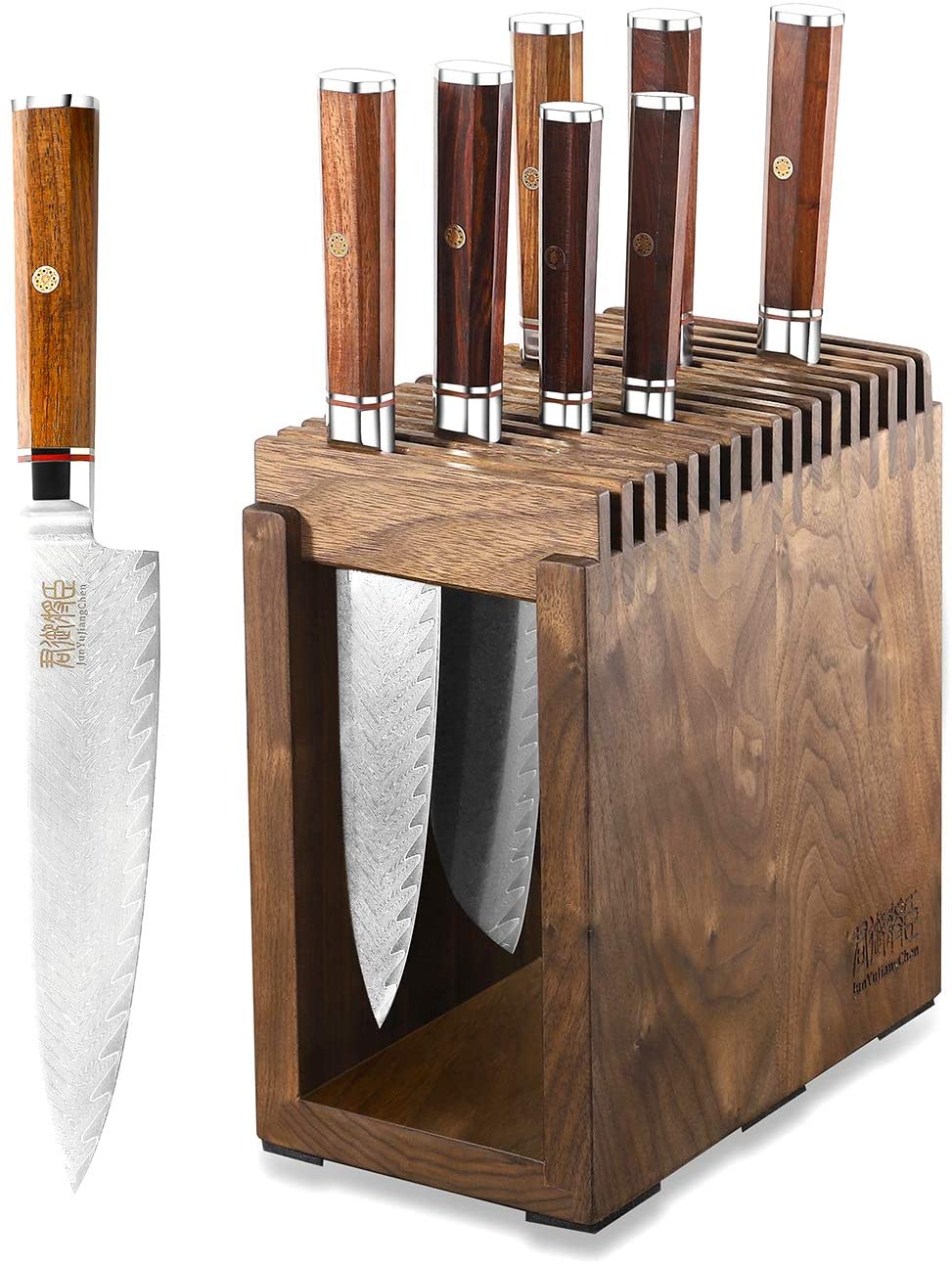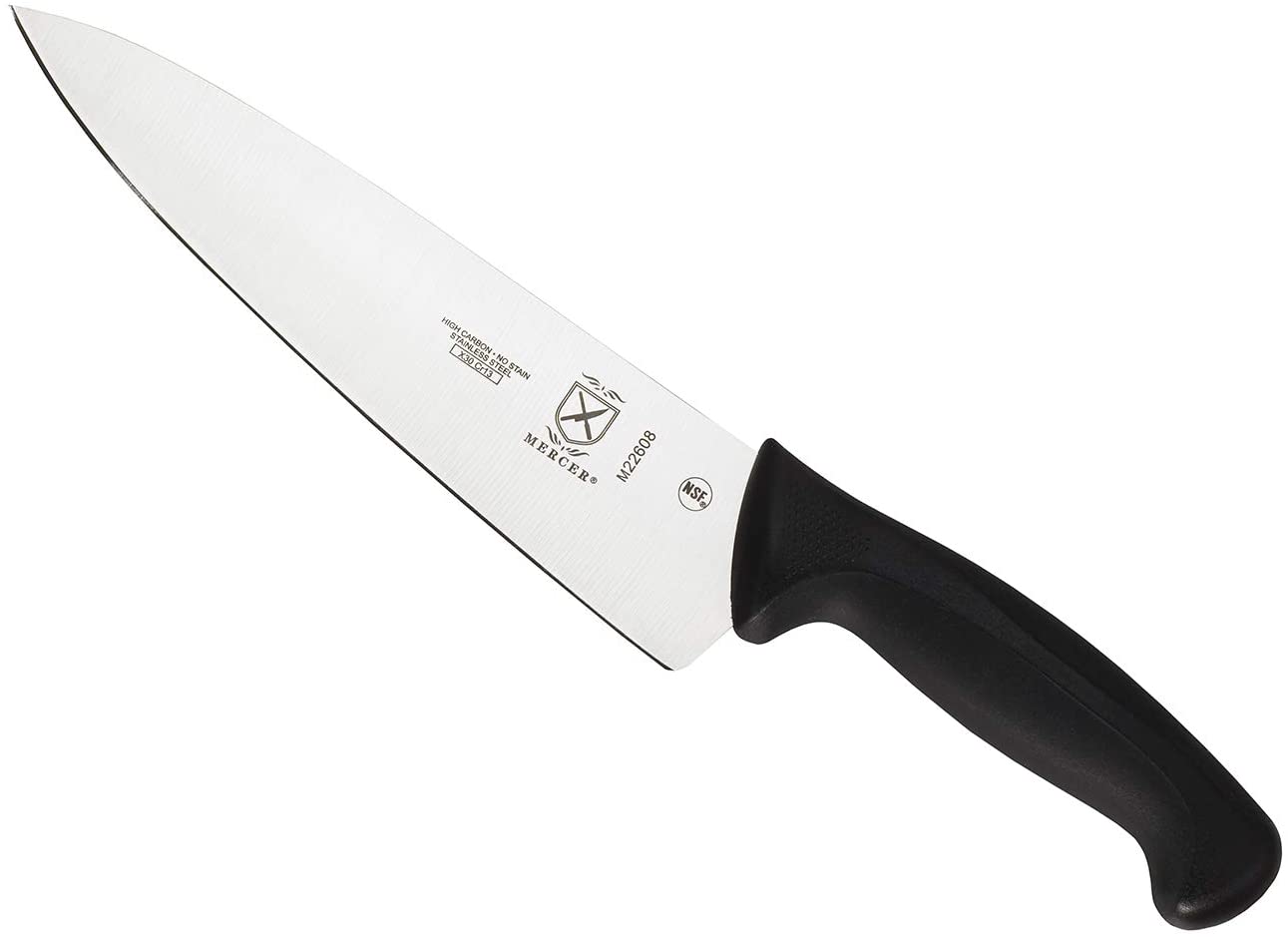Best Chef Knife
Cooking is a lot of fun, but a good meal takes time to prepare. Often, it involves a lot of chopping, slicing and dicing. Experienced chefs know that using the right tool helps get the job done faster, and that means having a good chef’s knife, one of the most important utensils in your food prep arsenal.
A good chef’s knife will become your new best friend, helping you cut through all the hard work of food prep. But with so many different models available, it can be hard to tell the good from the bad.
Some of the factors to consider when choosing a good chef’s knife include how the blade is made and what it is made of; how easy it is to use; the comfort and design of the handle and how well it fits in your hand; the length of the blade and its sharpness; its durability and of course, the price.
To help you wade through it all, we feature four chef’s knives you can purchase online. Read on to find the one that suits your needs best.
Top Pick Best All Around: Victorinox Fibrox Pro Knife
Every busy home cook needs basic utensils to be successful in the kitchen. One of the most important tools you’ll ever want to have in your arsenal is a good, sharp chef’s knife. For chopping, slicing, dicing and pretty much taking care of most of your food prep needs, you’ll need a well-made, reliable and durable knife to get the job done.
If you’re looking for that one, all-around great chef’s knife to begin your cooking journey, then we recommend this 8-inch knife from Victorinox. Expertly crafted with a tapered stainless steel edge that cuts with ease and efficiency, this knife is designed to handle any big or small kitchen task you need to get done.
This Swiss-made carving knife has a straight edge made from high-quality, lightweight European steel with an ergonomic handle to reduce hand and wrist fatigue and offers up a non-slip grip – even when wet. The long, sloping curved blade ‘rocks’ for effortless mincing and chopping while the flat spine gives you extra power when you need to slice through hard-skinned items.
Its razor-sharp edge rarely needs to be sharpened so all you get is ease and efficiency when slicing cooked and grilled meats and larger foods, every single time.
Pros:
- Fibrox Pro handle for a secure and comfortable grip
- National Sanitary Foundation (NSF) approved
- Weighted and balanced for easy handling
- Stainless steel blade
- Ideal for all kitchen tasks: dicing, mincing, chopping, slicing and shredding
Cons:
- Wash by hand
- Blade should be honed after a few uses
Top Pick Best Forged Chef Knife: DALSTRONG Chef Knife
A chef’s knife can be made in two different ways – forged or stamped. Savvy home cooks and professionals understand the superior quality of a forged knife, which is made by a skilled craftsman who melts metal until it can be reshaped into a blade. The result is a better performing knife made of premium materials that is easier to use.
We recommend this 8-inch forged chef’s knife if you are looking for a top-quality utensil that will service you for a lifetime. The blade on this chef’s knife is incredibly razor sharp, full-tang, made from imported high-carbon German steel with a hand-polished edge at 14-16 degrees per side – precisely tempered and stain resistant.
Prepare to be impressed with the knife’s award-winning design, satisfying heft, premium materials and quality feel. The ultra-premium G-10 handle is military grade with life-long durability, hand polished and crafted for superior control, agility and comfort. The blade, engineered to perfection at 56+ Rockwell hardness and hand polished to a satin finish, is carefully tapered for improved hardness, flexibility, and minimal slicing resistance.
Other distinguishing features include a tall blade height that provides useful knuckle clearance; a blade that is precision forged from a single piece of imported premium quality, high-carbon ThyssenKrupp German steel, ensuring an ultra sharp edge with excellent wear and stain resistance; and a water and stain resistant, BPA-free protective Dalstrong PerfectFit sheath in which to store the knife when not in use.
This kitchen workhorse will help you slice and dice with minimal effort, maintenance or cleanup, making it your favorite go-to utensil to get the job done right.
Pros:
- Hand polished satin finish blade
- Ergonomic handle shape for maximum comfort, grip and maneuverability
- Full tang
- Forged blade
Cons:
- More expensive than other models
3) Top Pick Best Set: JUNYUJIANGCHEN Kitchen Knives Set
There’s not much food prep you can do in the kitchen without the help of a good knife. Most aspiring chefs take their time choosing the right one and prefer to purchase their collection of knives one at a time to build their cutting arsenal. But if you are the type of cook who wants to start off equipped with a full set of quality slicing, chopping and dicing knives, then we suggest you consider this set.
In this collection, you find pretty much all you will need to prepare any kind of recipe for you, your family and friends. Complete with seven different knives – an 8-inch chef’s knife, a 6-inch Nakiri, a 3.5-inch paring knife, an 8-inch bread knife, a 7-inch santoku, a 5-inch utility and a 6-inch boning knife – it all comes with an exquisite black walnut block with a multi-slot design for an attractive and convenient place to keep them out of the way and organized.
The blades on all of the knives are hand-forged from Japanese AUS10 Super Steel 67-Layer Damascus with lovely rosewood handles that have strong, durable bolsters for perfect stability and control. These sharp, sturdy and practical knives will become your cherished set of tools to master all of your food prep requirements.
Pros:
- Blades hand-forged from high-quality Japanese steel
- Set includes seven different knives
- Comes with a walnut wood knife block with a multi-slot design
Cons:
- Expensive
Top Pick Best Basic: Mercer Culinary M22608 Millennia 8-Inch Chef’s Knife
You’re looking for that one great knife to begin your culinary journey but as a student, you’re on a pretty tight budget. That doesn’t mean you can’t find a good chef’s knife to set you on your way to creating delicious meals.
This eight-inch chef’s knife by Mercer really makes the cut – literally. The blade is made from high-quality Japanese steel that resists rust and corrosion, and is easy to care for. The blade is also designed for rapid sharpening to keep the edge razor-sharp.
The ergonomic handle is made from a combination of Santoprene for comfort and polypropylene for durability, with textured finger points for a safe, slip-resistance grip. NSF certified, this chef knife is a handy and affordable option that will take on any cutting, chopping, slicing or dicing task you need to get done.
Pros:
- Affordable
- 8-inch blade made from high-quality Japanese steel
- Ergonomic handle
Cons:
- Needs to be sharpened regularly
- Not recommended for the dishwasher; wash with warm water and soap only
Things to look out for:
Consider these things when looking for a chef’s knife so you will choose one that best suits your needs:
Forged versus stamping:
Forged: A forged blade involves using a mold and creating the knife from scratch in its liquid metal form. Usually, this kind of blade will run the entire length of the knife from the handle, making it substantial and durable. A forged knife often performs better than a stamped knife, is made of premium materials and is easier to use. A good forged knife will last a lifetime, but they tend to be pricey.
Stamped: Stamped knives are usually entirely machine made and cut from an existing sheet of metal. These knives are generally cheaper, less durable and are often inferior to forged blades. That being said, you can find excellent stamped blades that boast high quality materials, full tangs, and well-designed blades that hold a great edge.
Material:
The blade of a chef’s knife can be made from a variety of materials, each of which has its benefits and drawbacks.
Stainless steel: This is a relatively inexpensive metal and is rust-resistant, though the blade dulls easily and can be difficult to sharpen.
High-carbon steel: Pricier than standard stainless steel, high-carbon steel blades are robust and maintain their edge and sheen.
Titanium: These blades can be effectively sharp, relatively light and comfortable to use. However, their flexibility means they’re not ideal for cutting dense or hard materials.
Ceramic: A knife with a ceramic blade will maintain its sharpness for a long time and one that is well made is extremely precise. On the downside, they lack the weight and thick heel of other knives and are more fragile than high-end metals.
Budget:
Like most kitchen items, a chef’s knife is available in a range of prices, which is determined by the various features of a particular knife. Almost every type out there is available in both forged and stamped versions, so it’s possible to be selective if you’re on a budget. All that being said, it’s never a good idea to spend more than you can afford.
Use:
How you intend to use your chef’s knife is important in determining which one is right for you. For example, do you mostly chop food or will you only use the knife for slicing? Are you considering having only one knife to do it all, or do you prefer to own a few that can handle different tasks?
A chef’s knife with a narrower blade is more suited to slicing, while a broader blade is better for chopping. Curved blades can be “rocked” to cut softer foods rapidly, but they tend to be thinner and less suited to heavy cutting.
Frequency of use is also something to consider. If you will be using your chef’s knife a lot, then it might be worth investing in one of the highest quality that you can afford so it will last a long time. If you only intend to use the knife occasionally, then you can be a bit more flexible. If you’re the type of person who prefers premium quality kitchen utensils that will last a lifetime and get through all the slicing and dicing you do, it pays to purchase the very best that you can afford.
Some knifes comes with a box in which to keep it so it doesn’t have to be in the regular cutlery drawer where it may get nicked. Others come with a convenient sheath that you slip on to the blade when you’re not using it, while complete sets come with attractive holders made from various materials. These have slots to store each knife, keeping everything tidy, organized and safe. These different options will matter to you depending on how often you use your knife, the configuration of your kitchen and if there are kids in the house.
Maintenance:
It almost goes without saying that you should clean and dry your knives after every use. If you’ve invested in good knives, you shouldn’t need to sharpen them too often, however, for proper maintenance and safety, knives that become dull should be sharpened using the appropriate sharpening stone.




